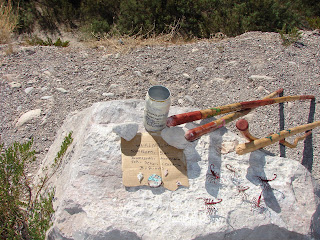Our first stop is the Action Figure Museum in Pauls Valley, Oklahoma. This is a collection of thousands of action figures with few explanations. This is the owner's collection on display, most still in the original packaging. Display of all the Batman figures required three large exhibits in a Bat Cave in the rear of the store. There were two hands-on play areas. One allowed visitors to try on various superhero costumes and admire themselves in a mirror.
The most amusing display was the collector's bedroom (shown below). The description at the front of the exhibit explained this was the bedroom of a collector who still lived at home (because who else could afford to buy every version of every action figure?), was overweight from eating cookies and lacked social skills.

Pictures of museum on Flickr.
Our next stop was the Oklahoma City National Memorial for the April 19, 1995 bombing of the Alfred P. Murrah Federal Building. This place has a memorial and a museum. The memorial is composed of several parts.
The street where the van exploded has been replaced by a long black granite reflecting pool. The bomb exploded at 9:02 am. At each end of the reflecting pool are tall black "gates" labeled 9:01 and 9:03 for the minutes before and after the explosion. The pool and panels capture the moment when the explosion changed us.
On the Federal building side of the street is a field of 168 empty chairs representing the children and adults who died in the explosion. The chairs are arranged in nine rows for the nine stories of the building.
In the picture below, the empty chairs are just outside the right side of picture. The camera is looking down the reflective pool toward gate 9:01. Behind the camera is gate 9:03.

Pictures of memorial on Flickr.
On the left side of the picture, the largest tree on the distant hill is the Survivor Tree, an American Elm that stood in the center of the parking lot across the street from the Federal building. The explosion badly damaged this tree. It lost all its leaves. After being heavily pruned, it sprouted growth and now symbolizes recovery from this tragedy.
To the left of the Survivor Tree is the Journal Record Building. The explosion heavily damaged this building. Three of its floors now house the memorial museum.
The museum begins by emphasizing how normal April 19, 1995 started. The explosion is represented by an actual tape recording of the beginning of Water Board hearing that began at 9 am on that day. Two minutes into the recording a loud explosion occurs. The explosion was so loud the tape was unable to capture its full resonance.
We then move into a room were we see the "live" newscasts immediately after the explosion. The rest of the exhibits document the experiences of the survivors, their families, the rescuers, the response of the public, the investigation and trial of the terrorists involved and world-wide media coverage up to the completion of the memorial itself. The coverage of these exhibits is very extensive and complete.
We arrived at home in Great Bend at around 9 pm Saturday night.











